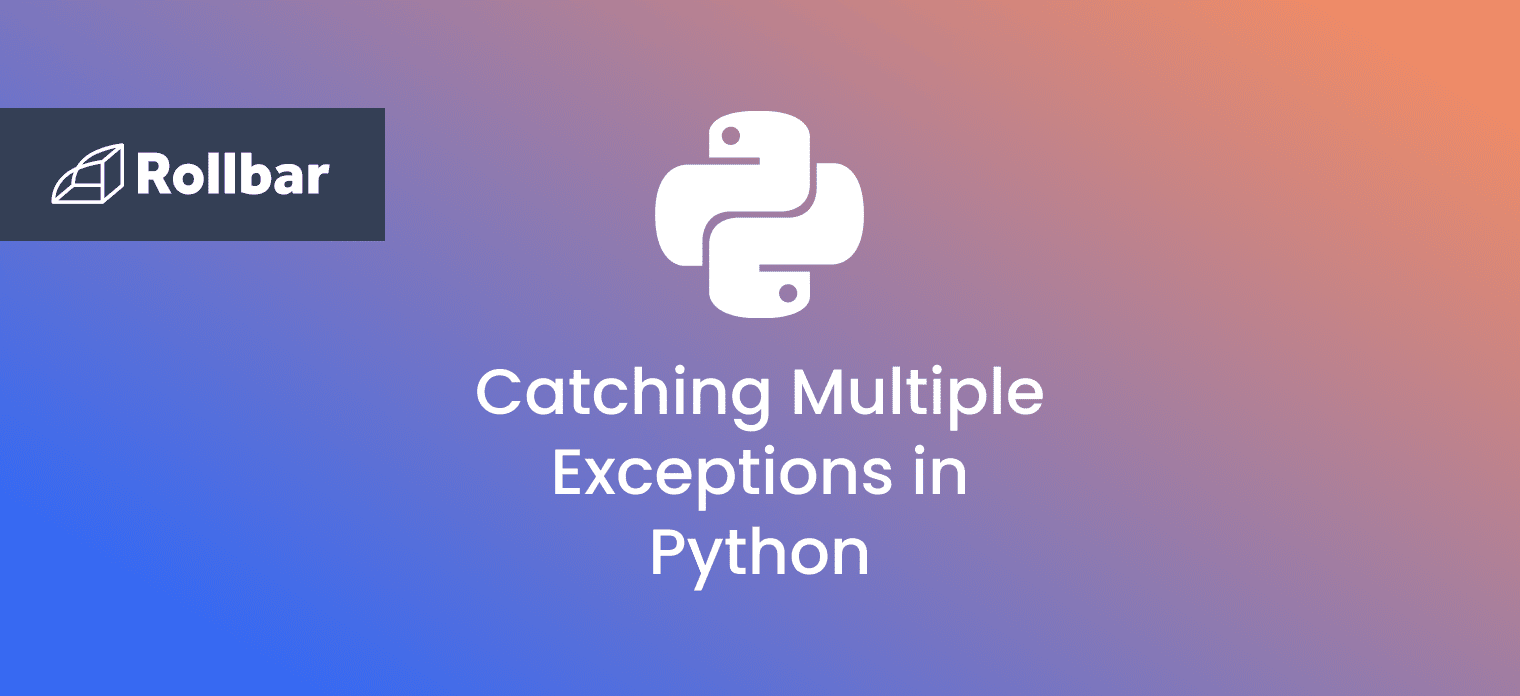Python: Catch Multiple Exceptions in One Line
Learn how to efficiently catch multiple exception types in a single except block using Python, simplifying your error handling code.
Learn how to efficiently catch multiple exception types in a single except block using Python, simplifying your error handling code.
In Python, you can efficiently handle multiple exception types within a single except block using a tuple. This approach simplifies your code and enhances its readability. Let's explore how to achieve this.
To catch multiple exceptions in a single except block in Python, you can use a tuple containing the exception types you want to handle.
For example:
try:
# Code that might raise exceptions
except (ValueError, TypeError) as e:
# Code to handle the exceptionsIn this example, if either a ValueError or a TypeError is raised within the try block, the except block will be executed. The as e part is optional and allows you to access the exception instance for further processing.
This Python code defines a function called "divide" that takes two numbers as input and returns their quotient. It includes error handling to catch cases where the inputs are not numbers or when attempting to divide by zero. The code then provides example usages of the function, demonstrating both successful division and error cases.
def divide(x, y):
"""Divides two numbers but handles potential exceptions.
Args:
x: The numerator.
y: The denominator.
Returns:
The result of the division.
Raises:
TypeError: If either input is not a number.
ZeroDivisionError: If the denominator is zero.
"""
try:
result = x / y
except (TypeError, ZeroDivisionError) as e:
print(f"Error: {e}")
else:
return result
# Example usage
print(divide(10, 2)) # Output: 5.0
print(divide(5, 0)) # Output: Error: division by zero
print(divide("hello", 2)) # Output: Error: unsupported operand type(s) for /: 'str' and 'int'Explanation:
divide(x, y) function:
x by y.try...except...else block is used for exception handling.try block:
except (TypeError, ZeroDivisionError) as e: block:
TypeError or a ZeroDivisionError occurs within the try block.e, allowing you to access its information (like the error message).else block:
try block.Key Points:
(TypeError, ZeroDivisionError) after except, you can catch multiple exception types in a single except block.as e part is optional but recommended, as it gives you access to the exception object for debugging or logging purposes.else block helps separate the code that should run only when there are no exceptions.Specificity: While catching multiple exceptions in a single block can be convenient, it's generally recommended to have separate except blocks for different exception types if you need to handle them differently. This makes your code more organized and easier to debug.
Exception Hierarchy: Python's exceptions follow a hierarchy. Catching a more general exception type (like Exception) will also catch its more specific subtypes. Be mindful of this hierarchy when deciding which exceptions to catch together.
Bare except Clause: Avoid using a bare except clause (without specifying any exception type) unless absolutely necessary. It can mask potential errors and make debugging difficult.
Logging: Consider logging exceptions within your except blocks. This provides valuable information for debugging and monitoring your application.
Alternatives: For more complex scenarios, explore using exception groups (introduced in Python 3.11) to group and handle multiple exceptions in a more structured way.
Readability: While using a tuple for multiple exceptions is concise, ensure it doesn't compromise readability. If the list of exceptions becomes too long, consider separate except blocks for better clarity.
| Feature | Description |
|---|---|
| Method | Use a tuple of exception types within the except statement. |
| Syntax | except (ExceptionType1, ExceptionType2, ...) as e: |
| Functionality | The except block executes if any exception listed in the tuple is raised. |
| Exception Access | Optional as e stores the exception instance for analysis and handling. |
| Example |
except (ValueError, TypeError) as e: catches both ValueError and TypeError. |
In conclusion, Python provides a streamlined way to handle multiple exception types within a single except block using tuples. This practice enhances code readability and efficiency. However, remember to prioritize specific exception handling when necessary and leverage logging for improved debugging. As you advance, explore exception groups for managing exceptions in more intricate scenarios. By mastering these techniques, you can write robust and reliable Python code.
 How to Catch Multiple Exceptions in Python – Real Python | In this how-to tutorial, you'll learn different ways of catching multiple Python exceptions. You'll review the standard way of using a tuple in the except clause, but also expand your knowledge by exploring some other techniques, such as suppressing exceptions and using exception groups.
How to Catch Multiple Exceptions in Python – Real Python | In this how-to tutorial, you'll learn different ways of catching multiple Python exceptions. You'll review the standard way of using a tuple in the except clause, but also expand your knowledge by exploring some other techniques, such as suppressing exceptions and using exception groups. How to Catch Multiple Exceptions in Python | Rollbar | Python try-except blocks can be used to catch/respond to processes that raises more than one possible exception, with a single except clause.
How to Catch Multiple Exceptions in Python | Rollbar | Python try-except blocks can be used to catch/respond to processes that raises more than one possible exception, with a single except clause. How to catch multiple exceptions in one line (except block)? | Better ... | Better Stack lets you see inside any stack, debug any issue, and resolve any incident.
How to catch multiple exceptions in one line (except block)? | Better ... | Better Stack lets you see inside any stack, debug any issue, and resolve any incident. How to Catch Multiple Exceptions in One Line in Python ... | A Computer Science portal for geeks. It contains well written, well thought and well explained computer science and programming articles, quizzes and practice/competitive programming/company interview Questions.
How to Catch Multiple Exceptions in One Line in Python ... | A Computer Science portal for geeks. It contains well written, well thought and well explained computer science and programming articles, quizzes and practice/competitive programming/company interview Questions. How can I catch multiple exceptions in one line (except block) in ... | I’m trying to catch multiple exceptions in one line using the except block in Python. I’ve tried using commas to separate the exceptions, but I’m getting a syntax error. Can someone please show me how to catch multiple exceptions in one line? Here’s the code I’ve tried so far: try: print(int('5.5')) except ValueError, TypeError: print(error) This code is giving me a syntax error on the except line. Can someone please show me how to correctly catch multiple exceptions in one line using...
How can I catch multiple exceptions in one line (except block) in ... | I’m trying to catch multiple exceptions in one line using the except block in Python. I’ve tried using commas to separate the exceptions, but I’m getting a syntax error. Can someone please show me how to catch multiple exceptions in one line? Here’s the code I’ve tried so far: try: print(int('5.5')) except ValueError, TypeError: print(error) This code is giving me a syntax error on the except line. Can someone please show me how to correctly catch multiple exceptions in one line using... How to catch multiple exceptions in one line? (in the "except" block) | How to catch multiple exceptions in one line? (in the "except" block)
How to catch multiple exceptions in one line? (in the "except" block) | How to catch multiple exceptions in one line? (in the "except" block) 8. Errors and Exceptions — Python 3.12.7 documentation | Until now error messages haven’t been more than mentioned, but if you have tried out the examples you have probably seen some. There are (at least) two distinguishable kinds of errors: syntax error...
8. Errors and Exceptions — Python 3.12.7 documentation | Until now error messages haven’t been more than mentioned, but if you have tried out the examples you have probably seen some. There are (at least) two distinguishable kinds of errors: syntax error...